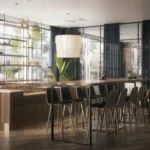What’s the Difference Between Designing for Commercial and Residential Architecture?
When it comes to architectural design, there are significant differences between designing commercial spaces and residential properties. Each category has its unique set of considerations, requirements, and design principles.
In this blog post, we’ll explore the distinctions between designing commercial architecture and residential architecture. We will shed light on the key factors that influence the design process.
1. Purpose and Functionality:
Commercial spaces are designed to serve specific functions and accommodate large numbers of people. Whether it’s an office building, a retail store, or a restaurant, the layout and design must optimise functionality, flow, and efficiency. Considerations such as traffic patterns, zoning regulations, accessibility, and space utilisation are crucial in commercial design.
On the other hand, residential architecture focuses on creating personalised living spaces for individuals or families. The design process revolves around creating comfortable, functional, and aesthetically pleasing environments that cater to the specific needs and preferences of residents. Factors like privacy, natural light, spatial organisation, and personalisation are prioritised in residential design.
2. Aesthetics and the atmosphere:
Commercial spaces often aim to create a brand identity or convey a particular atmosphere. The design elements, materials, colours, and lighting are carefully selected to align with the brand image and target audience. The ambience of a commercial space plays a crucial role in attracting customers, promoting productivity, and enhancing the overall experience.
Residential architecture focuses more on creating a personalised and comfortable environment that reflects residents’ preferences and lifestyles. Individual tastes drive the aesthetics and may vary greatly from one home to another. Factors such as creating a warm and inviting atmosphere, incorporating personal style, and considering long-term livability are key considerations in residential design.
3. Scale and size:
Commercial projects typically involve larger scales and sizes compared to residential properties. Office buildings, shopping malls, and hotels require careful consideration of floor area, circulation spaces, and vertical transportation. The design must accommodate many occupants and fulfill specific business requirements.
Residential projects vary in scale and size, ranging from small apartments to large-family homes. The focus is on creating comfortable living spaces that cater to the occupants’ needs. The design must balance functional spaces, efficient circulation, and a sense of intimacy and privacy.
4. Regulatory and Safety Considerations:
Designing commercial spaces involves navigating complex regulatory requirements and safety standards. Compliance with building codes, fire safety regulations, accessibility guidelines, and zoning restrictions is critical. Commercial architects must thoroughly understand these regulations and incorporate them seamlessly into the design process.
While residential architecture also has regulatory considerations, the scope is often more manageable than commercial projects. Compliance with local building codes, safety measures, and energy efficiency standards is essential. However, the focus is primarily on creating comfortable and safe living environments for occupants.
Designing commercial architecture and residential architecture requires a different set of skills, considerations, and priorities. Each category presents unique challenges, from functionality and aesthetics to scale and regulatory requirements.
Whether planning a commercial project or a dream home, it is crucial to work with experienced architects like 261 Degree Projects who understand the intricacies of commercial and residential design. With their expertise, you can ensure your project is executed seamlessly, meeting your objectives and exceeding your expectations.





